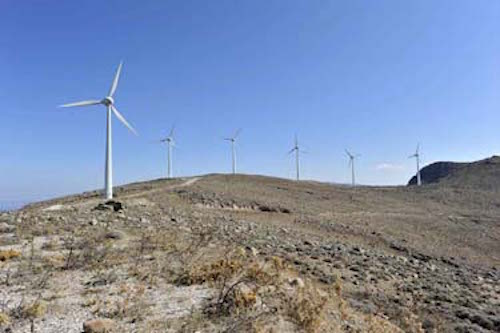(A few windmills in the West of Lesvos)
UNESCO is the largest organisation that tries to preserve the world’s heritage, both cultural and geological. However, last week they could not prevent the centuries’ old Bazaar in Aleppo (Syria) being burned to ashes, a victim of the civil war. It’s especially during wars that lots of world heritage gets lost.
Its not only buildings or towns that UNESCO protects, but also landscapes. There are 89 global Geoparks, situated in 27 countries, 52 of them in 18 European countries. According to Wikipedia: ‘A Geopark is defined by the United Nations Educational, Scientific and Cultural Organization (UNESCO) in its UNESCO Geoparks International Network of Geoparks programme as follows: A territory encompassing one or more sites of scientific importance, not only for geological reasons but also by virtue of its archaeological, ecological or cultural value.’
The country with most Geoparks is China, having 26 breathtaking nature parks registered with UNESCO. I wonder why none of the 41 national parks of Russia are on the list; but Greece has 4 Geoparks: Psiloritis Natural park on Crete, Chelmos – Vouraikos Geopark in the north of the Peloponnesos, Vikos Aoös Park in Epirus and The Petrified Forest in Sigri on Lesvos.
It is great that Lesvos has one of the 89 Geoparks of the world. Last September it was decided that the frontiers of the Lesvorian Geopark had to be enlarged: the whole island of Lesvos now has been declared a Geopark. So now I live in a geopark! And coming for a holiday to Lesvos now means that you come to a Geopark. It says something about the uniqueness of Lesvos with its petrified trees, its archaeological finds of very ancient settlements, its prehistoric bones and with its traditional villages in a differentiated and beautiful landscape.
Can the island remain a Geopark, I don’t know. Some years ago the 17 individual municipalities of Levos melted into one large cumbersome unit and the grapevine whispers that since then most money is kept at the capital of the island. Now the Municipality of Lesvos thinks it is time to industrialise the quietest part of the island – the west.
I thought that the time of industrialisation was over and that we now have the era of digitalisation. But nearly-broke Greece has another opinion and so most of the counsillors of the municipality will agree with the proposed project of the Spanish company Iberdrola to place on Lesvos (and Chios and Lemnos) an enormous wind turbine park.
I have already mentioned this project in DonQuiLesvos fighting the windmills.
It seems that the villages in this area expect more good than bad things from the plan. They probably don’t realise what implications this huge park could have for their silent and impressive nature that offers a home to rare birds and plants. The region will be turned upside down in order to make way for the 100 km of roads, each 5 to 10 metres wide, that need to be built to enable the installation of the turbines. Some mountaintops will also have to be flattened in order to make room for 153 wind turbines, each 67 metres high.
The west will be crossed by an electricitycable because the collected energy is not destined for the island’s use. The electricity from Lesvos, Chios and Lemnos will be collected here on the island and transported by cable to the mainland where the highest bidder can buy it. I assume that this cable will not be just the thin telephone cable they used to lay in the landscape going to a top of mountains so that firemen or other people could alarm authorities in the case of a wild fire (in the woods above Parakila you can still follow such a line for many kilometres all the way to the top of Profitis Illias; a great help when you get lost). And whilst Iberdrola promises that the inhabitants of Lesvos will benefit from their business, nobody knows how: 1 or 10 euro reduction on the ever-increasing electricity bills? There is even talk that the inhabitants should pay in order to keep the wind turbines going.
I can understand, that because of the crisis, lots of people will like someone to invest in their region. The question remains if there will be any profit from a project collecting energy that is transported immediately from the island to the mainland. The windmills do not need big maintenance, so that will not provide much employment and the 100 km of roads will probably be built by the cheapest roadworkers: foreigners (just like the buildings for the Olympic Games in 2004 were realized).
I am not against green energy but now that the whole of Lesvos has become a Geopark I wonder if such a huge windmill park belongs here. I do hope that UNESCO can convince the Greek state or Lesvorian Municipality that a Geopark offers a more abiding future than a foreign company coming to earn money for some years. Wind turbines have a lifetime of about 20 year after which they probably will be left as shot-iron.
Greece has put 40 islands up for rent, so Iberdrola, please go with your projects to such an island: no windmill park in a Geopark!











